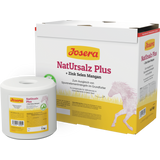Rules for safe handling of horses
Handling and riding horses can be dangerous if the basic safety rules are not followed. Whether you are learning to handle your first horse, or just leaning on the fence and watching your child's riding lessons, it doesn't matter - you should know a few basic safety precautions to prevent accidents and injuries when handling horses or when near them.
Even the calmest horse or pony has the potential to hurt someone when they get frightened or scared. The following recommendations can help you avoid bites, kicks, crushed toes and the like.
You may feel a little overwhelmed because you have just started riding and you need to remember so much. Don't worry, this will quickly pass and the safety rules will soon become a habit, much like when you look back and forth when crossing a street.
A startled horse
In the wild, horses used to be prey. As such, it was vital for them to react quickly and, if necessary, to outrun a predator even if an escape was not possible. That was the key to surviving in the wild. Even if predators no longer pose a danger to most horses, these strong instincts to survive in domestic horses have nevertheless been preserved and are still very pronounced - even if we strive to create the best and safest living environment for animals.
Because horses are escape animals, they can easily be startled and upset even long after what has frightened them is over. However, that always depends on the horse. Some animals are more reactive than others and are upset about things that other horses don't seem to notice. Therefore, especially for beginners, it is best to start working with a horse that is calm and relaxed.
Rules for the safe handling of horses
Here are the most important tips to reduce the dangers in the vicinity and in dealing with horses and thus to prevent injuries and dangerous situations.
- Draw attention to yourself
When approaching a horse, you should always draw their attention first. Also, always approach a horse from the front. - Quiet movements
Be quiet and calm. Avoid all types of sudden movements and loud noises. These can cause a horse to shy away, jump or bolt. - Never stand behind a horse
Never stand behind a horse. When you groom the tail, stand on your side and gently pull the tail towards you. - The safest place is next to a horse
The safest place to stand is next to your horse's shoulder, where you can see each other, or ten or more meters away - unless you groom or otherwise interact with your horse. - The right footwear
Wear sturdy shoes or boots when you are near horses, preferably with a reinforced toe area. If a horse steps on it, your feet are protected. NEVER wear sandals, flip-flops, mesh athletic shoes, or other thin shoes near horses. - Do not kneel or crouch
When cleaning a horse's hooves or bandaging legs, do not crouch or kneel. Bend forward so that you can quickly get out of the way when the horse moves. - Don't forget to tie-up
If you groom your horse, saddle it or clean your horse's stable, tie it up. A horse that can roam freely can wreak havoc. Do not leave a tethered horse unattended. It is safest during mucking out if the horse is driven out or brought into another box.
Use a quick-release knot or panic snapper when tying up so that your horse can be released quickly if it gets scared and pulls. Feeling constricted can cause a frightened horse to panic enough to hurt itself or yourself. - Lead a horse safely
The safest way to lead a horse is with a halter and a lead rope.
Do not put your fingers through the halter straps, rings or the bit. If the horse runs away, your fingers could get pinched, they could injure themselves or pinch your hand, causing you to be dragged along. - Never wrap anything around your hands or body
Never loop ropes, lunge lines or reins around your hands or other parts of the body. If your horse runs away, you could be dragged along. Never tie yourself to a horse in any way. - Feed treats properly
It is best to feed treats from buckets or tubs. Horses can get greedy very quickly and mistake your fingers for carrots. - Lead correctly through doors
When you walk through a door, make sure that the door is wide open so that the horse doesn't hit it. This can be frightening and lead to you being trampled or dragged along. If the door is tight, go through first, let the horse wait, and then only let it go after you while standing next to it.
Latest reviews
-
 4.8 (4)
4.8 (4)Starhorse Biotin Plus, 550 g
-10%- Biotin, Zinc & Methionine
- Slightly sweet taste
- With vanilla flavour
€ 26,95 € 29,99 (€ 49,00 / kg)Delivery by April 17
-
 4.0 (1)
4.0 (1)Josera NatUrsalz Plus - Horse Lick, 5 kg
-10%- Can be used in organic farming
- Salt lick with zinc, selenium & manganese
- High acceptance
€ 6,74 € 7,49 (€ 1,35 / kg)Delivery by April 17
-
 4.6 (71)
4.6 (71)GladiatorPLUS Gladiator Plus Horse, 1.000 ml
- Excellent ingredients
- High bioavailability
- Sugar-free
€ 91,99 (€ 91,99 / l)Delivery by April 17
-
 3.7 (3)
3.7 (3)leovet Milton White "Grey Shimmer", 550 ml
-10%- Fights discolouration
- Brilliant white effect
- Made with natural proteins
€ 15,25 € 16,99 (€ 27,73 / l)Delivery by April 17
